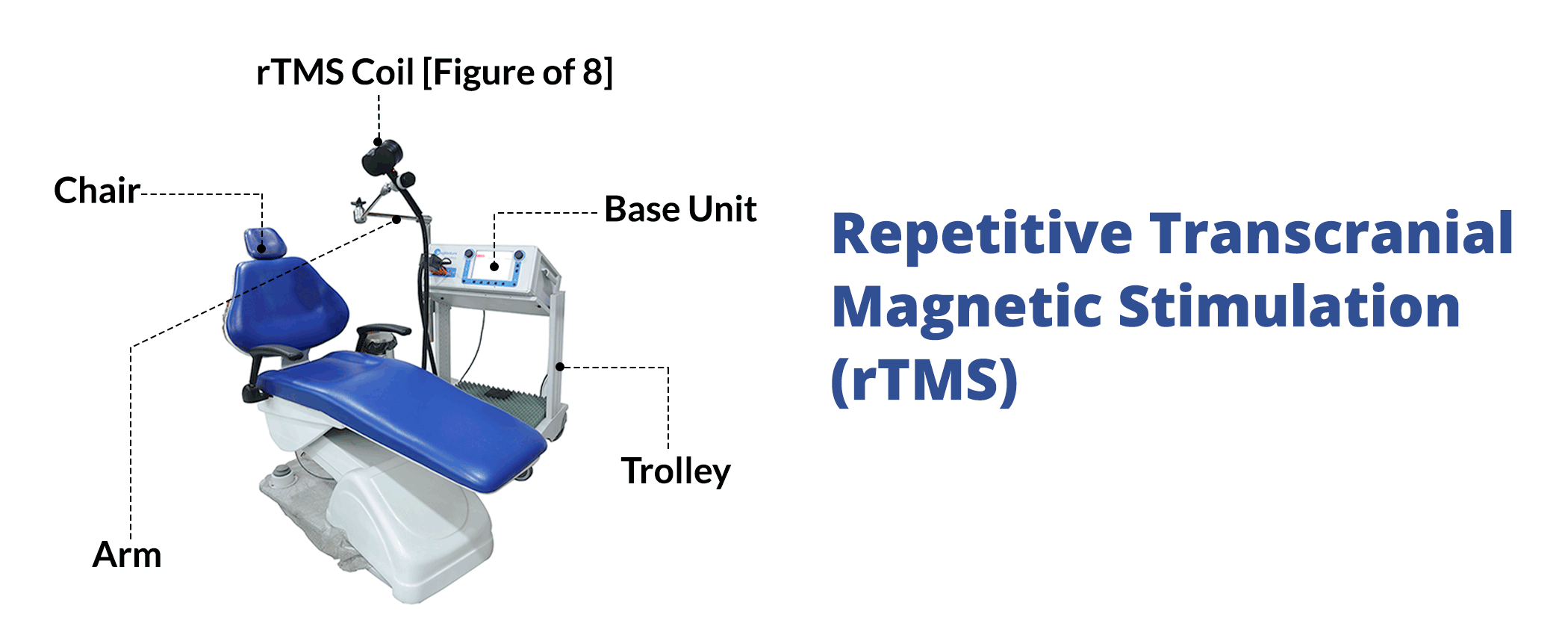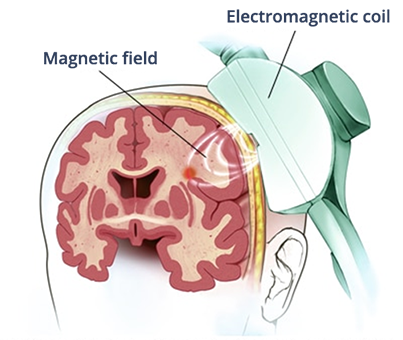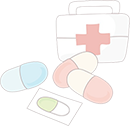
REPETITIVE TRANSCRANIAL MAGNETIC STIMULATION (rTMS)
rTMS stands for “repetitive transcranial magnetic stimulation.” rTMS is a non-invasive FDA-cleared medical procedure for the treatment of depression in adults. rTMS is a brain stimulation technique that depends on the generation of brief magnetic fields using an insulated coil that is placed over the scalp.
These magnetic fields are the same type and strength as those used in magnetic resonance imaging (MRI) machines. The magnetic pulses generate a weak electrical impulse in the brain that briefly activates neural circuits at the stimulation site. rTMS has been shown to be a safe and well-tolerated procedure that can be an effective treatment for adult patients with depression who have not benefitted from antidepressant treatment.
HOW DOES rTMS WORK?
During an rTMS session, a magnetic coil is placed against over scalp near your forehead. The magnet painlessly delivers a pulse that stimulates nerve cells in the region of your brain involved in mood control and depression. It’s activates the regions of the brain that have decreased activity in depression.

WHICH ILLNESSES/DISEASES HAS rTMS BEEN SUCCESSFUL IN TREATING?
The FDA approved rTMS to treat Treatment Resistant Depression in 2007.
Since then, rTMS has been used to treat a variety of psychiatric and neurological disorders with mixed results.
rTMS seems to be particularly most effective for:
- Major Depressive Disorder,
- Auditory Hallucinations,
- Anxiety Disorders,
- Pain Disorders.
- In patients with Obsessive Compulsive Disorder, who have been given a full trial of medications, but have not responded well, a trial of rTMS can be given with limited therapeutic benefit or long-term advantage.
Can rTMS be given if the patient is already on medicine?
Yes. This treatment will not interfere adversely with medication. Rather, both will have a complimentary effect on the underlying disease process.

HOW EFFECTIVE IS rTMS IN TREATING DEPRESSION?
rTMS is used to treat very severe cases of depression, especially those patients who do not adequately respond well to medications, or those in whom high dose medications are not usually well tolerated.

- In a study of 1383 patients, active treatment with rTMS was concluded to be better than Sham treatment.1
- In a pooled sample size of 230 patients, 47% patients achieved >50% reduction in symptoms when rTMS was added to the existing medication regimen.2
- Also, early initiation of rTMS along with medicines seems to be more effective than just prescribing medicines alone.
- An analysis of 213 patients revealed that when rTMS is combined with medicines, early in the illness, patients are “TWICE MORE” likely to achieve complete resolution of their symptoms, then those who are just on medication alone. (odds ratio 2.4, 95% CI 1.3-4.6) 3
QUICK FACTS ABOUT rTMS
For Medical Treatment Resistant Depression: 40 Sessions
For Depression Not Resistant to Medical Treatment: 20-30 Sessions
(Note: This will depend on the clinical status and response to medications)
Duration of a Session: 30 minutes approximately Two such sessions can be given simultaneously.
A form of treatment where such 4 sessions or 12000 pulses/day can be given safely.
With accelerated TMS, patients only need 10 days to complete the entire course of treatment.
rTMS is a procedure carried out on OPD basis and doesn’t require patient to be admitted in the hospital. There are no post-procedure complications or side effects and hence patient can go home after the session
Response is usually seen after 10-15 sessions are completed. Patients start feeling distinct changes in mood and energy levels.
In cases of accelerated rTMS, positive changes from treatment can continue up to 1 month post the delivery of rTMS.
In our clinical experience, patients who undergo adequate rTMS treatment, maintain the therapeutic effect for >1-2 years.
All patients who are started on rTMS need to continue with medications as prescribed before the start of rTMS treatment.
Symptoms can re-appear post an rTMS course, under two conditions:
a) If you are a treatment non-responder: Consider alternative form of brain stimulation, such as Brief Pulse Therapy
b) If you have relapsed: Consider maintenance rTMS.
HOW IS rTMS COMPARABLE TO ELECTROCONVULSIVE THERAPY (ECT)?
To understand the answer to this question, one must understand some other aspects.
| CONDITIONS REQUIRING ECT | |
|---|---|
| SUICIDAL THOUGHT/ACTIONS/ATTEMPTS | |
|
Melancholic Depression Depression with Psychosis |
Previous history of good response to ECT |
| Aggression/ Severe Irritability | Complete social isolation/ poor functioning |
| Significant feeling of hopelessness/worthlessness | Severely reduced appetite |
| Severe slowing of actions and thoughts | Residual symptoms not responding to medications |
| ADVANTAGES OF rTMS | |
|---|---|
| Mild-moderate depression | Improve treatment response at early stages of illness |
| stigma attached | No memory issues |
| Non-invasive Minimal-no side effect |
Safe in patients with other
|
| PREGNANCY: NO SIDE-EFFECT TO MOTHER/BABY. ABSOLUTELY SAFE | |
MOST COMMONLY EXPERIENCED SIDE-EFFECTS
- Headache
- Heaviness of head
- Tingling numbness of scalp
- Dizziness
All these side effects are self-limiting. Some patients need to consume an over the counter analgesic for the resolution of headache (e.g. Ibuprofen)
The most serious side effect with rTMS treatment is the possibility of a seizure occurrence. The probability of a seizure is ~0.01% to 0.1%
When any of the above mentioned symptoms are present, ECT is the treatment of choice and the effectiveness of ECT is far superior to rTMS.
| rTMS | Anti-Depressant Medicines | Normal Population | |
|---|---|---|---|
| Seizure Risk |
0.01% to 0.1% | 0.1% to 0.6% | 0.07% to 0.09% (Chances of spontaneous seizure generation) |
CONTRAINDICATIONS
| Contraindications | Relative Contraindication | Absolute Contraindications |
|---|---|---|
| History of Seizure Episodes/ Epilepsy or Brain DamageMetallic implants in the brain |
Cardiac Pacemakers
Implantable Defibrillators |
FAQs ON rTMS
Can I take rTMS alone, if I don’t want to take medicines?
The short answer is NO.
Medicines are a must to treat any psychiatric illness. They form the basis of treatment.
Any other form of treatment e.g. psychotherapy/counselling, neurostimulation methods are “ADDITIONAL “to medicines.
rTMS, in addition to medicines, can bring significant symptom improvement, very quickly.
What are the results of rTMS in Schizophrenia?
Many patients with schizophrenia experience auditory hallucinations.
25% of patients with schizophrenia have treatment resistant hallucinations. rTMS targeted over the auditory cortex has the potential to significantly reduce the occurrence of voices.
Also, rTMS can be used to improve motivation, mood and memory of patients with schizophrenia.
Can rTMS help in recovery after a brain stroke?
Post-Stroke depression is very common in patients who have suffered a stroke recently. A course of rTMS, using the same depression protocol, can significantly reduce the severity of depression and improve functioning.
Anti-depressants have to be given cautiously post stroke, hence rTMS can serve as a non-invasive and potential alternative.
Also, a course of rTMS has been shown to improve spasticity, decrease weakness or paresis and induce movements in paralysed limbs. The effects are most pronounced immediately post stroke, up to 1 month.
Does rTMS have a role to play in Migraine?
Yes. It has been used for its role in preventing the Migraine attacks from taking place and can reduce the frequency & severity of the Migraine headache.
What is the role of rTMS in Fibromyalgia & Pain Management?
Patients report a measurable reduction in pain after rTMS. It has a selective effect by increasing pain tolerance & altering pain processing, thereby providing long-lasting pain relief.
REFERENCES
- 1)Slotema CW, Blom JD, Hoek HW, Sommer IE. Should we expand the toolbox of psychiatric treatment methods to include Repetitive Transcranial Magnetic Stimulation (rTMS)? A meta-analysis of the efficacy of rTMS in psychiatric disorders. J Clin Psychiatry 2010; 71:873.
- 2)Liu B, Zhang Y, Zhang L, Li L. Repetitive transcranial magnetic stimulation as an augmentative strategy for treatment-resistant depression, a meta-analysis of randomized, double-blind and sham-controlled study. BMC Psychiatry 2014; 14:342.
- 3)Berlim MT, Van den Eynde F, Daskalakis ZJ. High-frequency repetitive transcranial magnetic stimulation accelerates and enhances the clinical response to antidepressants in major depression: a meta-analysis of randomized, double-blind, and sham-controlled trials. J Clin Psychiatry 2013; 74:e122

